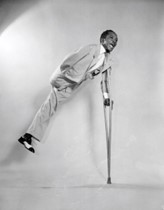In
the 1940s and 1950s, Heard was well-known in various venues across the
United States and Canada, entertaining audiences with his innovative
dancing. He appeared in a movie called "Boarding House Blues" in 1948
and on a television variety show called "You Asked for It" in the 1950s.
Black entertainers had limited Hollywood, television, and music
opportunities at that time. Heard’s performances would start with him
dancing using a crutch. Less than a minute later, he would throw his
crutch offstage and continued to dance. Heard,
would visit hospitals, and participate in community events, challenging
stereotypes about people with disabilities. He challenged the idea that
people with disabilities couldn't live fulfilling lives. He proudly
used the term "crip" as his stage name, reclaiming it from being an
insult. He also volunteered with organizations supporting people with
disabilities and encouraged others in his community to follow their
dreams. Heard
eventually settled in Chicago, where he had a family and worked various
jobs. He faced numerous challenges, including surviving a violent
robbery and healing after a severe fall. Still, he continued to advocate
for people with disabilities until he died in 1991. Heard's
legacy lives on through contemporary artists redefining dance and
disability, making performances more inclusive for everyone. |
|

No comments:
Post a Comment